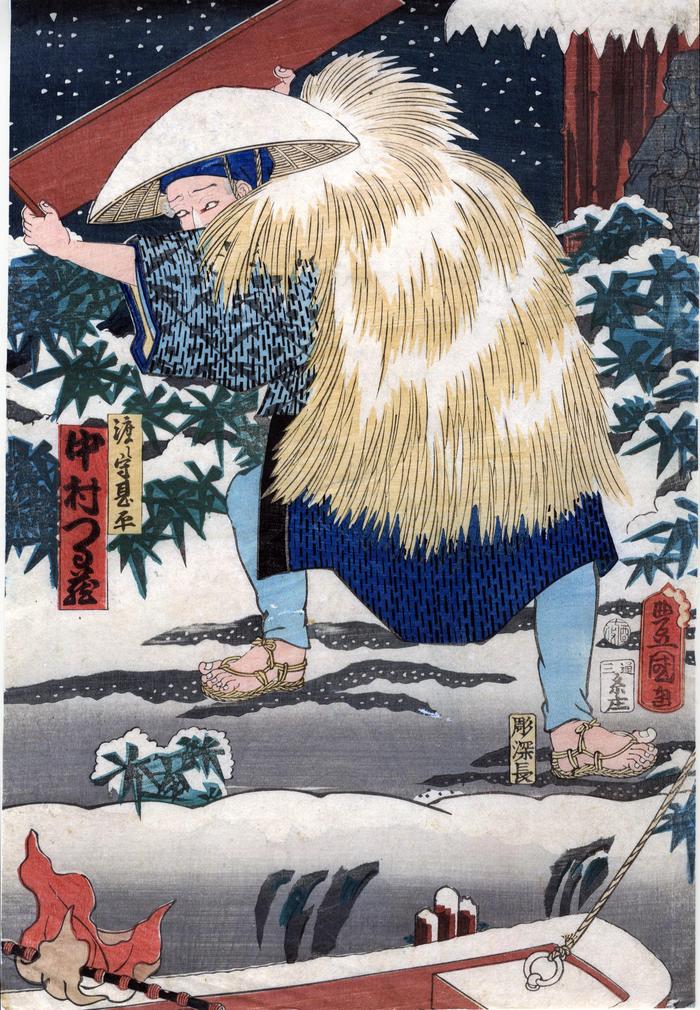Utagawa Kunisada (歌川国貞) / Toyokuni III (三代豊国) (artist 1786 – 01/12/1865)
Nakamura Tsuruzō I (中村つる蔵) as the ferryman Jinbei (渡守甚平) from the play Sakura Sōshi Gonichi no Bundan (桜荘子後日文談) based on Higashiyama Sakura Zōshi ('The Story of Cherry Blossoms on Higashiyama': 東山桜荘子)
08/1861
Signed: Toyokuni ga (豊国画)
Publisher: Itoya Shōbei
(Marks 167 - seal 24-041)
Combined censor/date seal: aratame and 7/1861
Carver: Hori Shinchō (彫深長)
Museum of Fine Arts, Boston - an 1851 Kuniyoshi diptych representing this same play
Museum of Fine Arts, Boston - an 1851 Toyokuni III diptych with a scene from this same play
Kunitachi College of Music Library
Funabashi City Library - another scene from this play
Ritsumeikan University - another Toyokuni III print of Jinbei with a board in his hands The name Jinbei is sometimes spelled Jinpei.
Jinbei is a minor character, a ferryman or watashimori (渡し守), who risks his own life to help a friend who had been wronged. Helping his friend is forbidden by the authorities, but his loyalties are too deep. He is a good guy who many of the audience goers would have been rooting for.
Above are a few links to other representations of Jinbei to help you better to understand this singular print seen out of context.
We resolved what Jinbei is doing with that board in his hand after finding another print by Toyokuni III at Ritsumeikan University. Click on that link above and you will see Jinbei trying to protect his old friend from an attacker.
****
Kabuki 21 wrote: " "Higashiyama Sakura Zôshi" was premiered in the 8th lunar month of 1851 August at the Nakamuraza... The true incident on which the play was based occurred in 1653... When it was dramatized, the names and details, even the era (Muromachi instead of Edo), were changed because of censorship by the shogunate government. For example, the head of the village Kiuchi Sôgo, the evil lord Hotta Masanobu and the shôgun Tokugawa Ietsuna became Asakura Tôgo, Orikoshi Masatomo and Ashikaga Yoshimasa in the drama. Segawa Jokô III mixed in his drama the farmers riot and elements taken from Ryûtei Tanehiko's popular novel "Nise murasaki Inaka Genji" (commonly called "Inaka Genji"). This drama was revised by the playwright Kawatake Shinshichi II. He got rid in his version of the "Inaka Genji" elements. It was staged in the 8th lunar month of 1861 at the Moritaza... under the title "Sakura Sôshi Gonichi no Bundan". The drama was revised during the Meiji era and the real names of the main protagonists were used instead of the names created by Segawa Jokô III."
Kabuki21 gives a summary of the performers in the play Sakura Sōshi Gonichi no Bundan (桜荘子後日文談) which debuted at the Moritaza in 8/1861. These were Ichikawa Kodanji IV as Asakura Tôgo, Katagiri Saizô, Kôzen; Nakamura Tsuruzô I as the boatman Jinbei, Maboroshi no Chôkichi, Yamana Sôzen; Ichikawa Kuzô III as Orikoshi Masatomo, Ogata Nagatonosuke; Onoe Kikujirô II as Oshizu-no-Kata, Tôgo's wife Omine; Arashi Hinasuke VI as Ashikaga Yoshimasa, Kamimura Hayato; Ichikawa Ichizô III as Yamanaka Shikanosuke, Hozumi Shinjûrô; Bandô Mitsugorô VIas Princess Kaoru; Ichikawa Yonejûrô II as Asakura Tôzaemon, Sakubê; and Nakamura Fukusuke II as Izutsu Onnanosuke, Umezu Kamon.
[We have highlighted in bold type the names of actors who are included in prints in the Lyon Collection as of July 2025.]
Itoya Shōbei (糸屋庄兵衛) (publisher)
actor prints (yakusha-e - 役者絵) (genre)
Nakamura Tsuruzō I (初代中村鶴蔵: 11/1818 to 8/1865) (actor)
